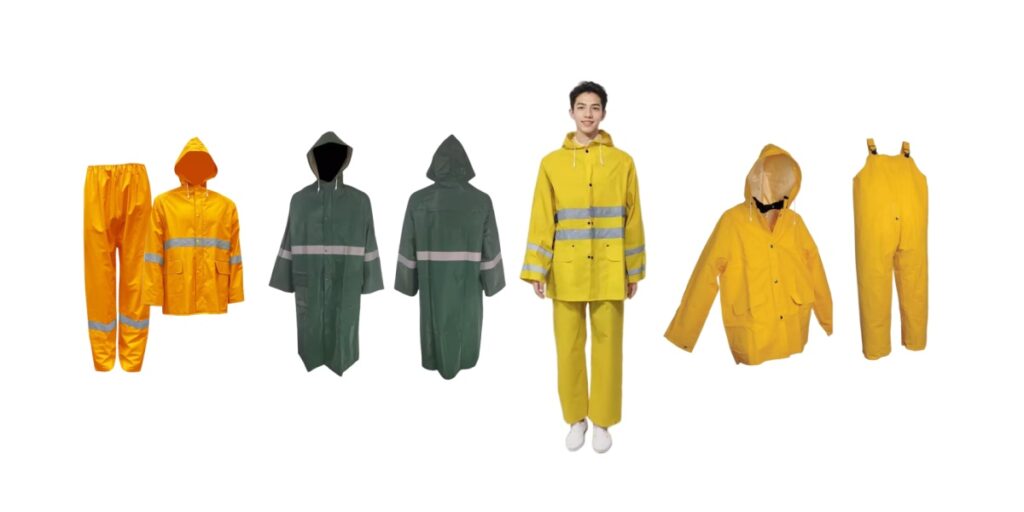PVC/polyester raincoats are a common and practical type of waterproof clothing, widely used in outdoor work, traffic duty, agriculture, industry, warehousing, construction, etc. These raincoats have excellent waterproof performance and also possess certain resistance to acids, alkalis, oil stains, and mild chemical corrosion, making them highly suitable for special operation environments such as factories, equipment maintenance, cleaning, etc. Their structure is composed of wear-resistant polyester base fabric and waterproof PVC coating. The overall product is sturdy, durable, safe to wear, and has a moderate cost. To ensure the actual usage effect, wearing comfort, and long-term durability, during the procurement or inspection process, it is necessary to conduct a comprehensive assessment of the raincoat quality from multiple dimensions, such as material, thickness, workmanship, waterproof performance, durability, and detailed craftsmanship.

How to evaluate the quality of a PVC/polyester raincoat?
Material Composition of PVC/Polyester raincoat
- The high-quality product is made of PVC coating + 100% polyester base fabric (polyester), with a smooth and thick surface.
- Low-quality products may contain recycled materials or be insufficiently proportioned. They have a thinner texture, an unpleasant smell, and are prone to tearing.
Thickness and Weight
- The common thicknesses are 0.28 mm to 0.50 mm.
- The higher the weight, the stronger the wear resistance and tear resistance, but the softness may decrease.
- It is more accurate to conduct actual measurements using a caliper or a weighing scale.
Waterproof Performance
- A simple water spray test can be conducted to observe if there is any leakage or water droplets remaining.
- The high-quality PVC layer should be completely waterproof, free from bubbles and delamination.
- After pulling, there should be no breakage or whitening (fading/aging).
Workmanship and Craftsmanship Evaluation of PVC /Polyester Raincoat (Applicable to High-Frequency Hot Pressing Process)
Hot Pressing Joint Quality
- The high-frequency hot pressing process melts and bonds the PVC layers under high temperature and pressure, eliminating the need for traditional sewing and glue application.
- Check whether the seams are smooth, free of bubbles, without delamination, and without any burnt marks.
- A qualified hot-pressed joint should be firmly bonded and should not be easily torn or broken apart.
Weld Seam Consistency
- All joint areas (such as shoulders, armpits, cuffs, and hat connections) should have no obvious misalignment or skewing.
- The width of the heat-sealing line should be uniform, with a smooth and natural curvature transition, without affecting the appearance or the wearing feel.
Fastener/Fabrication Firmness
- Buttons, zippers, and accessories should be securely fastened on the reinforced area or the heat-sealed strengthening strips to prevent tearing.
- The zipper moves smoothly, and the waterproof cover is fully in place.
- The related accessories (such as the hat strap, eyelet, and elastic band) are heat-sealed firmly and do not easily come off.
Design Rationality
- The overall fabric of the raincoat fits the human body structure closely, allowing for flexible movement without being tight.
- The hat is adjustable, the cuffs have a windproof design, the hem length is moderate, and it is suitable for various working postures.
- Some of the higher-end models also feature ventilation holes or breathable structures to enhance the wearing comfort.
Practicality and Durability Test of PVC/Polyester Raincoat
Comfort of wearing
The size should fit well, and the interior should not be too hot.
The material should be moderately soft and lightweight and should not restrict movement.
Does it come with ventilation holes (such as those on the armpits) or a back ventilation structure?
Tensile/tear resistance
Manually pull the hem, cuffs, and seams to check if they are prone to tearing.
High-quality PVC fabric should possess basic toughness and extensibility.
Odor and Environmental Friendliness
Check for any pungent PVC odor. Poor-quality plasticizers can be harmful to the human body;
Packaging and Labeling of PVC/Polyester raincoat
- Are there clear labels for size, material description, and place of origin?
- The products are neatly packaged in transparent bags/PE bags in individual units, suitable for retail sales or large-scale shipments.
Common Procurement Pitfalls—PVC/Polyester Raincoat
| Problem Description | Risk Explanation |
| Inferior or reduced material quality | Actual PVC thickness is lower than stated; easy to tear or crack during use. |
| Use of recycled or second-hand materials | Strong chemical odor, poor durability, faster aging, and non-compliance with environmental standards. |
| Poor heat-seal bonding | Seams may split or peel under tension or repeated folding. |
| Low-quality buttons or fasteners | Snaps or zippers may rust, fall off, or malfunction, affecting usability and lifespan. |
| Lack of ventilation design | Causes heat buildup and discomfort during prolonged wear. |
| Inaccurate sizing or labeling | Mismatched sizes lead to fitting issues and increased return rates. |
| No test reports or certifications | Unable to verify waterproofness, chemical resistance, or compliance with safety standards. |
Polyester/PVC Raincoat Conclusion
A high-quality PVC/polyester raincoat should not only have strong water resistance but also possess good tensile strength, comfort, and detailed workmanship. When purchasing, it is important to avoid solely focusing on low prices while neglecting quality. It is recommended to request samples before placing an order, conduct actual comparisons and tests, and require the provision of material inspection reports to ensure stable quality in batches and safe and reliable usage.
If you have any doubts about the PVC/polyester raincoat, contact us freely.


